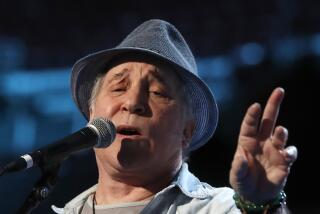Music Links Worlds of Sound and Silence
- Share via
LAWRENCE, Kan. — For Alice-Ann Darrow, the sound of silence can be a soothing melody or a thunderous rhythm.
The associate professor of music therapy at the University of Kansas has chiseled out a specialty that seems preposterous to some and quite obvious to others--music in the deaf culture.
“Many deaf people do enjoy music even if they hear very little of it,” Darrow said. “Some others could do perfectly well without it.”
Combining her love of music and a fascination with sign language, Darrow has tried to forge a link between the worlds of sound and silence. She teaches hearing people to use sign language and helps those with hearing problems to appreciate the sensory stimulation of music.
“Very few hearing-impaired people have no hearing at all,” she said. “Most can hear something,” if only a change in rhythm, pitch, volume or melody.
Those skills have a practical value hearing people often take for granted. A rapidly increasing sound, even if faintly detected, might signify an oncoming train, for instance.
Darrow is not hearing-impaired, but her father was. She was inspired both by his frustrations to communicate and by a book, “The Heart is a Lonely Hunter” by Carson McCullers, in which a deaf man struggles against his isolation.
As a music therapist in the 1970s in Florida, Darrow learned that some hearing-impaired students have “a lot of musicality that bypasses the ear--it was innate.”
That set off a series of studies that have shaped her career in an emerging academic field. Her latest project, soon to be published, surveyed how deaf and hearing-impaired people make use of music.
“How do deaf people perceive music?” she asked 300 deaf people nationwide. “Does it have a role? Or is it an egotistical part of the hearing population that says you can’t live without this wonderful thing called music?”
One respondent said he felt left out at Christmastime, when so much of the celebration involves music.
“Some who had lost their hearing later in life have memory tapes,” Darrow said. “When they see a performance, it turns on those memory tapes and they remember what a song sounded like.”
Others said they enjoy the physical process of playing a piano even if they cannot hear the music.
Still, even some deaf people question her efforts.
“Don’t you know deaf people can’t hear music?” one deaf respondent wrote. “Music has no place in deaf culture. You’re wasting the university’s money.”
But Diane Merchant, the music director at Gallaudet University in Washington, D.C., said “musical ability does not necessarily correlate with hearing ability.
“There are people who are deaf who are also musical, and Alice-Ann Darrow’s work is particularly necessary because music is seen as being outside of deaf culture.”
More than 150 students at Gallaudet, a college for the deaf, take an elective music course each semester. Each student learns to play an instrument.
And at the Miss Deaf Kansas contest this year, two of the three finalists gave musical performances as their talent entries.
One device Darrow has used in her research resembles a cushioned bed, equipped with built-in speakers from head to toe. The musical vibrations hit different parts of the body, allowing a person on the bed to detect changes in rhythm, pitch, volume and melody.
“You can use the tactile sense to train the ear,” Darrow said. “We try to get across the idea that hearing and listening are two different things.”
Darrow credits recent movies and a television series starring deaf actress Marlee Matlin with helping to increase interest in deaf culture, particularly sign language.
“The movies did a lot to get across the idea that it’s not just the deaf person’s responsibility to learn how to speak,” she said. “It’s just as much the hearing person’s responsibility to learn to communicate with the deaf.”
More to Read
Sign up for Essential California
The most important California stories and recommendations in your inbox every morning.
You may occasionally receive promotional content from the Los Angeles Times.













